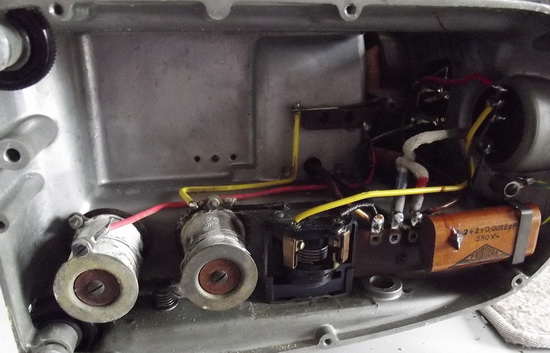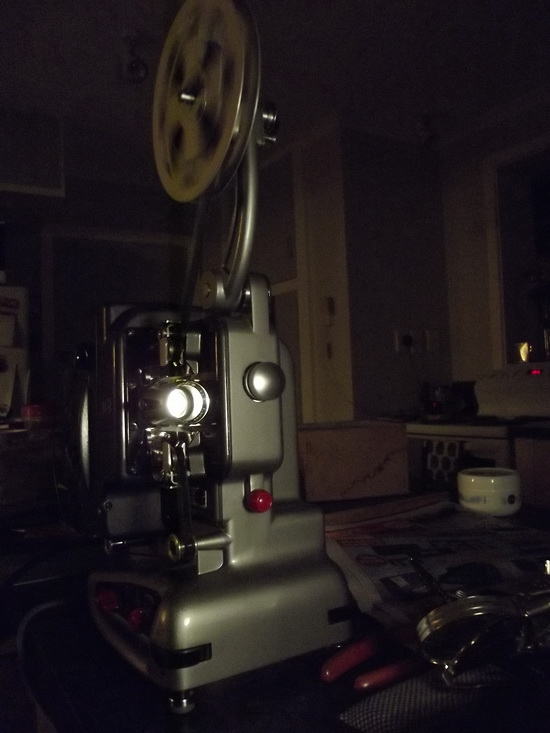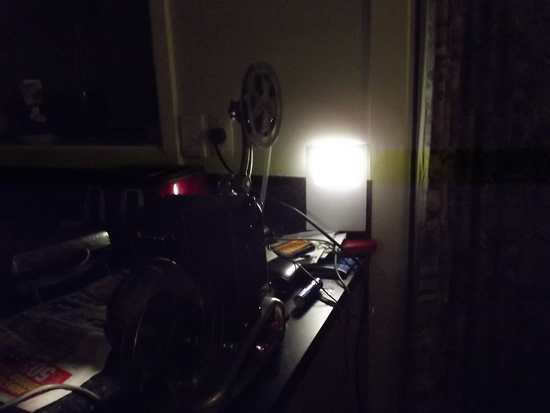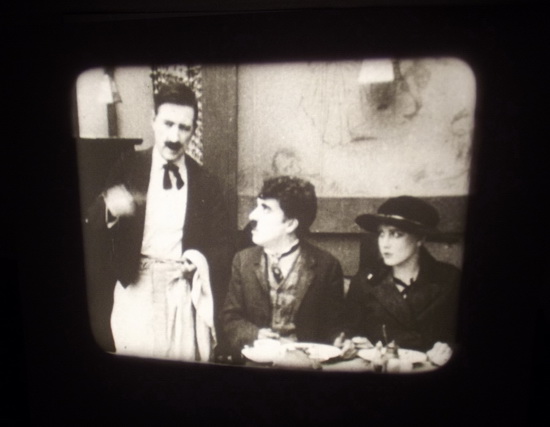This is topic The Bolex M8 in forum 8mm Forum at 8mm Forum.
To visit this topic, use this URL:
https://8mmforum.film-tech.com/cgi-bin/ubb/ultimatebb.cgi?ubb=get_topic;f=1;t=010849
Posted by Graham Ritchie (Member # 559) on July 31, 2016, 07:42 PM:
I decided last weekend to bring this little projector back to life. The variable speed control was a mess, so I replaced it with a modern electronic one. The capacitor that's supposed to kick in if the speed gets to slow and bring it up to speed went POOOOF, so that was the end of that. Anyway I was not keen on using that capacitor as it might POOOOF my new electronic control. The projector now runs like a charm, and will hold a constant speed with none of this up and down stuff.
The projector is a really nice machine and certainly was very expensive to buy in its day at around 86 pound back in 1958.

Please remember folks this is "mains voltage" I am playing around with so I would not recommend you doing this at home.

Out with the old and in with the new...and it works ![[Smile]](smile.gif)

I gave the commutator a good clean plus a light scrape between the segments. The motor is still in excellent condition.

To get the speed right 18fps I just need to get the 50 cycles on the stroboscope to stop turning.

Posted by Barry Fritz (Member # 1865) on July 31, 2016, 09:33 PM:
Nice work, Graham. I agree they are beautiful, nice running machines. Mine looks like it was made yesterday. They are functional but also nice for display.
Posted by Graham Ritchie (Member # 559) on August 01, 2016, 01:58 AM:
Thanks Barry.. my first projector was a SM8 bought second hand back in the 1970s, that also was a very nice machine. ![[Smile]](smile.gif)
Posted by Janice Glesser (Member # 2758) on August 01, 2016, 03:03 AM:
Graham...what can I say...your diversified knowledge and skill sets amaze me. What you've done to restore these beautiful vintage projectors is truly remarkable. I love seeing your handy-work ![[Smile]](smile.gif) Keep it coming!
Keep it coming!
Posted by Andrew Woodcock (Member # 3260) on August 01, 2016, 04:51 AM:
Great professional repair there Graham. Very well done indeed! ![[Smile]](smile.gif)
![[Smile]](smile.gif)
![[Wink]](wink.gif)
Posted by Michael Lattavo (Member # 4280) on August 01, 2016, 06:40 AM:
That's amazing! My electrical know-how is zero! Very impressive!
Posted by Andrew Woodcock (Member # 3260) on August 01, 2016, 07:30 AM:
Mine isn't, but even I am left wondering how on earth a cap start arrangement comes into play on a D.C. motor? ![[Confused]](confused.gif)
Posted by Paul Adsett (Member # 25) on August 01, 2016, 09:54 AM:
Well done Graham!
When I was a young lad in the UK, the M8R was my dream projector, the most gorgeous looking projector you could possibly imagine(it still is). I would stare at it for minutes on end in the window of a Cardiff camera shop, studying every facet of its beautiful design.
Totally beyond reach for me of course at that time, the price was equivalent to about two month's wages for the average working man. But for me the M8 always was the benchmark of quality in movie projectors.
And, it is worth noting that many of the film path design features of the M8 were passed on to it's equally beautiful successor, the Bolex 18-5.
Posted by Barry Fritz (Member # 1865) on August 01, 2016, 01:04 PM:
Bolex made three models of the M8 that I have owned. The silver model, with and without the stroboscope, and a crinkle finished olive green model. I cannot imagine why they made the green one. Based on the color, one might guess it was a military version, but there is no mention of that, to my knowledge. They also came in several different types of carrying cases. The weak spot on them is the speed control but your ingenuity has fixed that Graham.
The only model I still have is the silver with the stroboscope. I will never sell it.
Posted by Graham Ritchie (Member # 559) on August 02, 2016, 04:26 AM:
Thanks everyone.
One thing Andrew did mention that the motor is DC. The thing is this projector motor runs on AC and its been that way from day one. I can only guess it will take either AC or DC, anyway here are a few measurements taken tonight. The range of motor operation is from 50ACV to 190ACV with a nil reading on DCV setting.
Holding at50 Cycles at 130ACV, and 60cycles at 120ACV.
As I have a spare "bridge rectifier" rated at 600V 10A I thought I would fit it, between the two wires going to the motor and from the output side at the speed control. This would change the voltage from AC to DC and see what happens. Well nothing changed, the motor ran just as well on the DC, as it did on the AC input it does appear to make no difference.
I ran some film, and when adjusted to the 50 cycles on the stroboscope, the projector speed stayed spot on. The image on the screen looked like the speed was correct...so that's it, I am happy.
The added "bridge rectifier" is the black thing on the left of the picture.

Running some film in the kitchen after fitting the rectifier.



Taken from the bit of paper on the wall.

Posted by Maurice Leakey (Member # 916) on August 02, 2016, 05:05 AM:
"The Immigrant" ?
Charlie and Edna can't pay for their meal, (his coin has fallen through a hole in his pocket.)
Posted by Stuart Reid (Member # 1460) on August 02, 2016, 06:35 AM:
One of my favourite Chaplins, and a beautiful projector. Perfect.
Posted by Graham Ritchie (Member # 559) on August 03, 2016, 03:24 AM:
Well I came across this interesting article tonight in "8mm magazine October 1964" written by Peter West regarding motors.
"Series motors"
As discussed last month, up to a few years ago most 8mm, cine projectors were designed to cater for both alternating and direct current mains supplies; therefore, they were fitted with "universal" series-wound motors which would operate equally well on either type of current.
A second advantage of this type of motor is that it is easy to vary its running speed over wide limits while still obtaining useful power; all that is necessary is to vary the supply voltage-easily accomplished by a rheostat wired in series with the motor and mains supply.
The End... ![[Smile]](smile.gif)
I came across this article by accident, but it confirms to me as to what my thoughts were earlier on,. So there you have it from an expert way back in 1964.. AC or DC...it does not matter. Its food for thought if you do own one of those projectors like the "M8" if you need to come up with some type of replacement variable speed control. ![[Smile]](smile.gif)
Posted by Andrew Woodcock (Member # 3260) on August 03, 2016, 05:22 AM:
Interesting Graham.
I've never come across such a motor on any Super 8mm machine I've ever owned.
The ones with a commutator run on a D.C.suppy, the ones without run on an A.C. supply.
Perhaps these motors were used more universally in earlier projector designs than I'm familiar with.
That's all I can think of to explain this.
http://www.electricaleasy.com/2014/02/universal-motor-construction-working.html
In industry we used to manufacture very large Shunt, Series and Compound wound D.C. machines up to 750hp at the motor manufacturer I served my time with.
We used these older machines as generators on the test bed when coupled to the large AC induction motors the company produced in my years with them.
One of the earliest generators made in England came from this very same company.
As an early apprentice at the time,with the aid of a skilled fitter and winder,I assisted in the renovation of this machine to full working order.
Cosmetically, it was like a new machine once completed also.
Every lamination was removed and recoated in insulating varnish before rewinding the entire machine.
It still runs on display to this day I believe at the Museum Of Science & Industry here in Manchester.
Posted by Graham Ritchie (Member # 559) on August 03, 2016, 06:17 PM:
Andrew
Thanks for that link its certainly interesting as to how those motors were wired up back then.
I was reading that when the designers turned to using low-voltage lamps, which, because of the need for a transformer limited the projector to AC mains, induction motors started to be fitted.
They were cheaper and quieter than the series motors. More importantly the speed of a induction motor depends mainly on the mains frequency and within quite wide limits, is independent of voltage and load. Projectors using such motors therefore ran inherently at fixed speeds.
Britain and many other countries that are in the 220-240 volt range are usually 50 cycles. Where as 110-120 volts and some in-between voltages, are 60 cycles.
Its been an interesting project to bring to bring back to life a projector that otherwise would have been no more than a static museum piece.
I will leave in place the bridge rectifier for a DC current supply to the motor, with the thought that the $3 rectifier fitted, will in itself give a certain amount of protection to the new control board.
I hope the information here might be of help to anyone else thinking of bringing one of those early variable speed silent projectors back to life ![[Smile]](smile.gif)
Posted by John Last (Member # 3414) on August 04, 2016, 04:09 PM:
Andrew, I have replaced the mains capacitor with one from Maplins. This unit is only a suppressor and has nothing to do with motor starting.
Posted by Graham Ritchie (Member # 559) on August 04, 2016, 07:11 PM:
John
There is one another capacitor on the M8. What it does is that if the motor speed gets to slow, a mechanical lever swings over breaking the contacts thus allowing a sudden discharge to bring the motor above the min speed. This keeps the film from burning, its a safety thing. If you still don't adjust the projector speed, you will get the motor going up and down each time the contacts open and close and as such the capacitor will be busy kicking in and out.
Another safety on the M8 is the a "warning audio noise" at the same time... rat a tat tat ![[Smile]](smile.gif) Once again the speed has to be increased to stop all this going on. Its all designed to make sure the projector cant run to slow and damage your film from the lamp heat.
Once again the speed has to be increased to stop all this going on. Its all designed to make sure the projector cant run to slow and damage your film from the lamp heat.
Visit www.film-tech.com for free equipment manual downloads. Copyright 2003-2019 Film-Tech Cinema Systems LLC

UBB.classicTM
6.3.1.2
![[Smile]](smile.gif)
![[Smile]](smile.gif)
![[Smile]](smile.gif) Keep it coming!
Keep it coming!
![[Smile]](smile.gif)
![[Smile]](smile.gif)
![[Wink]](wink.gif)
![[Confused]](confused.gif)
![[Smile]](smile.gif)
![[Smile]](smile.gif)
![[Smile]](smile.gif)
![[Smile]](smile.gif) Once again the speed has to be increased to stop all this going on. Its all designed to make sure the projector cant run to slow and damage your film from the lamp heat.
Once again the speed has to be increased to stop all this going on. Its all designed to make sure the projector cant run to slow and damage your film from the lamp heat.